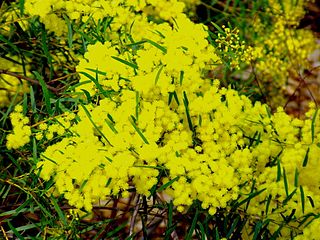
Acacia fimbriata, commonly known as the fringed wattle, Brisbane golden wattle, or just the Brisbane wattle, is a species of Acacia that is native to much of the east coast of Australia. It is one of the floral emblems of the city of Brisbane, Queensland.
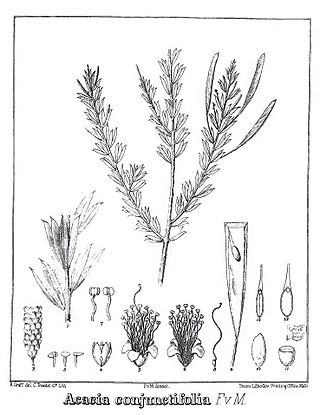
Acacia conjunctifolia is a shrub belonging to the genus Acacia and the subgenus Juliflorae. It is native to parts of northern Australia.

Acacia drepanocarpa is a shrub belonging to the genus Acacia and the subgenus Juliflorae native to northern Australia.

Acacia hammondii, also known as Hammond's wattle, is a tree or shrub belonging to the genus Acacia and the subgenus Juliflorae that is native across northern Australia.

Acacia lirellata is a shrub belonging to the genus Acacia and the subgenus Juliflorae that is endemic to south western Australia.

Acacia oncinocarpa is a shrub or tree belonging to the genus Acacia and the subgenus Juliflorae that is endemic to northern Australia.

Acacia bracteolata is a shrub belonging to the genus Acacia and the subgenus Phyllodineae endemic to Western Australia.

Acacia calcicola is a shrub or tree of the genus Acacia and the subgenus Plurinerves that is native to parts of central Australia. Common names for this species include; shrubby wattle, shrubby mulga, myall-gidgee, northern myall and grey myall. Indigenous Australians the Pitjantjatjara peoples know the tree as ikatuka, the Warlpiri know it as jirlarti and the Arrernte know it as irrakwetye.
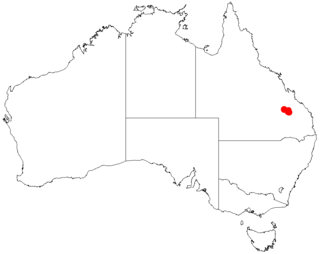
Acacia hockingsii, also known as Hocking's wattle, is a shrub belonging to the genus Acacia and the subgenus Phyllodineae that is native to parts of north eastern Australia.

Acacia semirigida, also known as stony ridge wattle, is a shrub or tree belonging to the genus Acacia and the subgenus Phyllodineae native to north eastern Australia.

Acacia torringtonensis is a species of flowering plant in the family Fabaceae and is endemic to a small area in northern New South Wales in Australia. It is an erect or spreading shrub with crowded, linear to narrowly elliptic phyllodes and spherical head of yellow to bright yellow flowers.
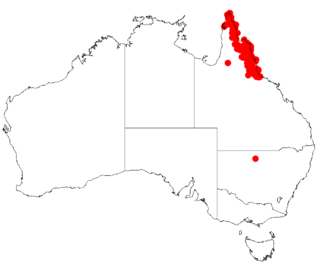
Acacia calyculata is a shrub belonging to the genus Acacia and the subgenus Juliflorae that is native to north eastern Australia.
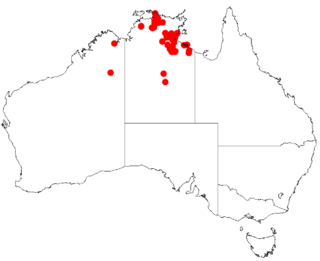
Acacia conspersa is a shrub or tree belonging to the genus Acacia and the subgenus Juliflorae that is native to northern Australia.

Acacia cretata is a shrub or tree belonging to the genus Acacia and the subgenus Juliflorae that is native to north eastern Australia.
Acacia gracillima is a shrub or tree belonging to the genus Acacia and the subgenus Juliflorae that is native to north western Australia.

Acacia striatifolia is a shrub or tree belonging to the genus Acacia and the subgenus Juliflorae that is native to north eastern Australia.

Acacia williamsiana is a tree or shrub belonging to the genus Acacia and the subgenus Juliflorae that is native to eastern Australia.

Acacia pycnostachya, also known as Bolivia wattle, is a shrub or tree belonging to the genus Acacia and the subgenus Juliflorae that is native to eastern Australia.

Acacia legnota, also known as heath wattle, is a shrub of the genus Acacia and the subgenus Plurinerves that is endemic to an area of north eastern Australia.

Acacia microsperma, commonly known as bowyakka, is a shrub of the genus Acacia and the subgenus Plurinerves that is endemic to an area of eastern Australia]. It is rated as least concern according to the Nature Conservation Act 1992.






















